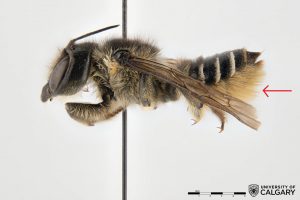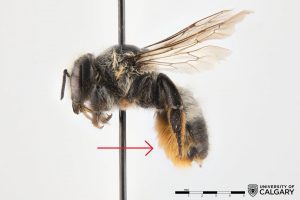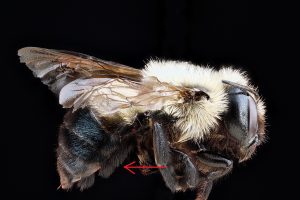Functions
Get, Store or Distribute Resources: Capture, absorb, store, distribute and expel – Solids
Maintain Community: Provide Ecosystem Resources – Pollinate
The scopa (plural scopae) is a collection of electrostatic hairs used to collect pollen as the bee forages. The scopa can vary in shape, size, and location, depending on the type of pollen collected. Scopa tend to have a top layer of long, stiff hair to hold pollen and an underlayer of short, flexible hair to absorb oils. The bottom layer can be made up of separate hairs or hairs branching off the upper layer. Generally, the larger and more interspersed the hairs, the larger the pollen grains that the scopa can hold.1 Bees that collect small pollen granules have denser, multibranched scopal hairs compared to bees specialized for large grains.2
The scopa is often found on the hind legs, characterized by dense rows of hair. The scopa may also be found on the underside of the abdomen, such as in the Megachilidae family. Pollen caught on other places on the bee, such as the head, can be brushed off using the foreleg using special hairs and packed into the scopa as needed.1
The corbicula, or pollen basket, is a specialized scopa that is able to carry both pollen and nectar. The moisture of the nectar allows the pollen to be tightly packed down, increasing the carrying capacity. This kind of scopa is found on more familiar bees like honey bees and bumblebees.
Some bees lack a scopa entirely, such as kleptoparasitic bees which lay their eggs in the nests of other bees and have no need to forage for pollen. Other bees ingest the pollen instead, storing it in a specialized part of their gut known as the crop.3
In the examples below, note how densely the hairs are packed and how much longer they are on the scopa than on the rest of the bee.


A female Melissodes rivalis (left) and Andrena peckhami (right) from the University of Calgary Invertebrate Collection. Both have their scopa on their hind legs. Melissodes rivalis has such a prominent scopa that it’s referred to as having “pollen pants”, while Andrena peckhami has very prominent curves to the long scopal hairs.



Female Megachile inermis (left, University of Calgary Invertebrate Collection), Megachile melanophaea (middle, University of Calgary Invertebrate Collection) and Osmia bucephala (right, USGS Bee Inventory and Monitoring Lab). Each have abdominal scopae.
Some of the stunning images on this page are courtesy of Sam Droege and the USGS Bee Inventory and Monitoring Lab, which develops identification tools and surveys for native bees.
This page was created by Holly Kerstiens in collaboration with Dr. Mindi Summers, Dr. Marjan Eggermont, Dr. Jess Vickruck, Lincoln Best and Dr. Alex Ralevski as part of an independent studies project in winter 2019. This information is also available as a collection on AskNature.org.
Sources
1 The Bees in Your Backyard – A Guide to North America’s Bees.
Princeton University Press. 2014.
Williams, P.H., Thorp R.W., Richardson L. & Colla, S.
2 Structural, Behavioral, and Physiological Adaptations of Bees (Apoidea) for Collecting Pollen.
Missouri Botanical Garden. 1979.
Thorp, R.W.
3 The Bees of the World
Hopkins Fulfillment Service. 2007.
Michener, C.D.
